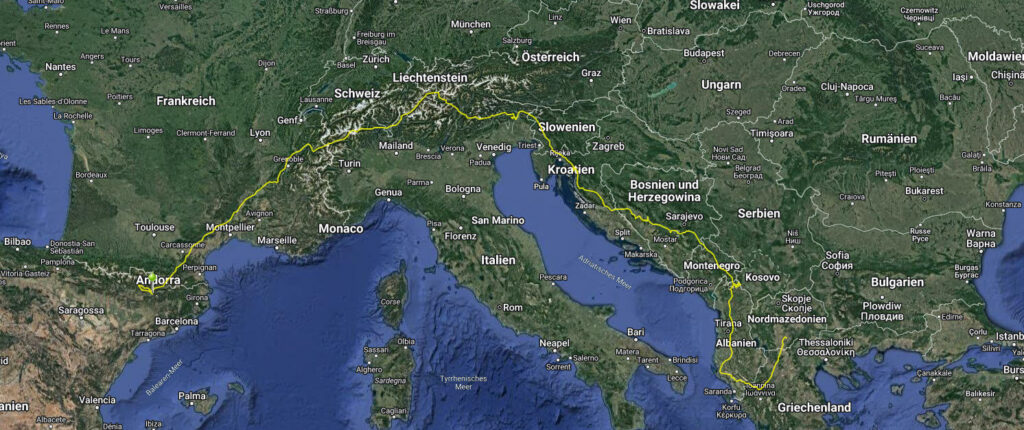Strengthening the population of Europe’s most vulnerable vulture species requires a combination of conservation measures and creative technics. The LIFE Gyp’Act project, working to consolidate the metapopulation of Bearded Vultures (Gypaetus barbatus) between the Alps and the Pyrenees, is setting up a “proactive monitoring system” to prevent mortality causes by using GPS-tagged Griffon Vultures. In June 2023, 16 Griffon Vultures (Gyps fulvus), the most abundant vulture species across European skies, were captured and fitted with GPS transmitters, and their information will be fundamental to inform upcoming conservation measures.

Griffon Vultures tagged with GPS transmitters, a proactive monitoring system to reduce vulture mortality
In the Haute-Vallée de l’Aude (Aude region, France), 16 Griffon Vultures were captured in a wire mesh cage installed in a natural feeding area. The process started weeks before; the local teams regularly placed carrion to get the vultures used to feed inside the cage. On June 5, on a regular feeding day for the 16 Griffon Vultures captured, the cage was closed, and the birds could be tagged by a local team of experts and released again once the tagging mission was accomplished.
It is not the first time Griffon Vultures have been tagged in a project to strengthen Bearded Vulture populations in France. During the successful LIFE GypConnect project, which induced the establishment of new population nuclei in the Drôme and the Massif Central in France, 10 Griffon Vultures were captured and fitted with GPS tags. Griffon Vultures have also been supporting Bearded Vulture conservation in captivity. In Spain, for instance, three Griffon Vultures that are irrecoverable are in the Guadalentín Bearded Vulture Captive Breeding Centre, acting as sentinels to help detect the West Nile Virus.
Why is it important to tag Griffon Vultures?
The data collected from the Griffon Vultures’ GPS transmitters will play a vital role in supporting well-informed decisions regarding upcoming conservation measures. The monitoring teams following their moves will better understand the bird’s habits and dispersal range across the Aude region and the surrounding mountain ranges. It will also help identify feeding areas during (and outside) the breeding season and, finally, flag areas with a high risk of vulture mortality.
During the Gyp’Act project, which will run until November 2028, 70 to 90 Griffon Vultures and Cinereous Vultures (Aegypius monachus) will be fitted with GPS transmitters, for active surveillance.
Pascal Orabi, LPO France, LIFE Gyp’Act project coordinator


Mitigating threats for (Bearded) Vultures
Collision with power lines or wind turbines, electrocution in energy infrastructures and illegal wildlife poisoning are the main anthropic threats affecting vultures’ survival. By analysing the eventual mortality causes of the GPS-tagged Griffon Vultures, the LIFE Gyp’Act team will have better insights into how – and where – to act. The project foresees the insulation and security of 20 km of power lines, previously identified by the LIFE GypConnect project and the Gyps sentinel team that was tagged before.
Other actions to increase knowledge and information about collisions with wind turbines will also be organised. When it comes to fighting illegal wildlife poisoning, an anti-poison dog unit will be mobilised and capacity-building sessions will be held with the participation of the Wildlife Crime Academy. Awareness-raising campaigns will be directed to farmers to avoid the use of indiscriminate poisoned baits and to hunters, to support the transition to lead-free ammunition.
Where are the tagged Griffon Vultures?
The LIFE Gyp’Act team has shared the most updated moves of the tagged Griffon Vultures. Twelve seem to be nesting in the Aude (whilst the previous ten tagged within the LIFE GypConnect were mainly breeding in Spain). Most of them are using the feeding stations located in the Aude region, including those who are breeding in Spain. One of the Griffon Vultures seems to be regularly visiting an area outside the known feeding places, and two Bearded Vultures were recently seen in that area.
Some Griffon Vultures have even reached the Cévennes (over 350 km of distance!) in less than 24 hours, corroborating their fantastic flying – and soaring – skills. As obligate scavengers, vultures have developed incredible adaptations that enable them to search for carrion through vast territories. They can fly hundreds of kilometres in a single day! To do that, they use updrafts (or thermals) to stay aloft and glide through the sky without actively flapping their wings – thus, conserving their energy.


Read the story of a Griffon Vulture that flew all way from Spain to the Balkans and back!
Many thanks to all those who provided their skills and knowledge for the successful capture and tag of the Griffon Vultures. The action was coordinated by LPO Aude, with the support of the CEFE team, veterinaries from the CNITV and ENVT, and the volunteers and staff from the LPO Occitanie. This project is part of a collective approach by the LIFE partners, with birds being equipped in the three massifs in partnership with the team led by Olivier Duriez, Senior Lecturer at the University of Montpellier (CEFE CNRS).
About the LIFE Gyp’Act Project
The LIFE Gyp’Act conservation project aims to consolidate South-eastern France’s Bearded Vulture (Gypaetus barbatus) population, ensuring the connection between the Pyrenean and Alpine populations. The project builds on the encouraging results of LIFE GypConnect, implemented between 2015-2022, whose actions contributed to establishing six new Bearded Vulture pairs across the French Pre-Alps and the Massif Central.

LIFE Gyp’Act is a 13M€ project, co-funded by the EU’s LIFE programme, that will run until 30 November 2028. Project partners are LPO – Ligue pour la Protection des Oiseaux as coordinator beneficiary, and the Vulture Conservation Foundation, Association Vautours en Baronnies, LPO Auvergne-Rhone-Alpes, LPO Occitanie, Sorbonne Université, ENEDIS, Centre National d’Informations Toxicologiques Vétérinaires, Parc National des Cévennes and Parc Naturel Régional du Vercors as associated beneficiaries.




